Managing battery usage is the foremost aspect of an electronic device to conserve the performance of the battery and prolong the battery life. Moreover, Windows 11/10 is constantly upgraded, adding new features that ease the management of battery life. While the constant upgrades seem to improve the battery life overall significantly, some users have reported battery drain issues. When it comes to battery drains, display brightness and processors are the ones that consume a lot of battery power. Additionally, the complex task that involves hardware processing will eventually drain your battery life.
Fix Battery drain issues in Windows laptop
Before discussing solutions to fix these battery drain problems, we suggest you unplug the accessories connected to the system. Also, try to reduce your startup programs and close all the dispensable programs and lower screen brightness that may assist in boosting the battery life. Apart from these tips, you may want to check out the following solutions to elevate the life of a battery.
1] Turn on the Battery Saver Mode
Sometimes, after a system update, the battery-saver mode may be toggled off, and you need to turn on the battery-saver manually. The Battery saver mode allows users to control battery power consumption to have maximum on-time. By enabling the battery-saver mode, your system will automatically restrict all the applications that are running in the background. To enable Battery Saver Mode, follow these steps:
Windows 11
First, right-click the Start button on the Taskbar and choose Settings from the list of options displayed therein. Alternatively, you can use Win+I keyboard shortcut to go to the settings window directly.
Next, select System from the side panel on the left.
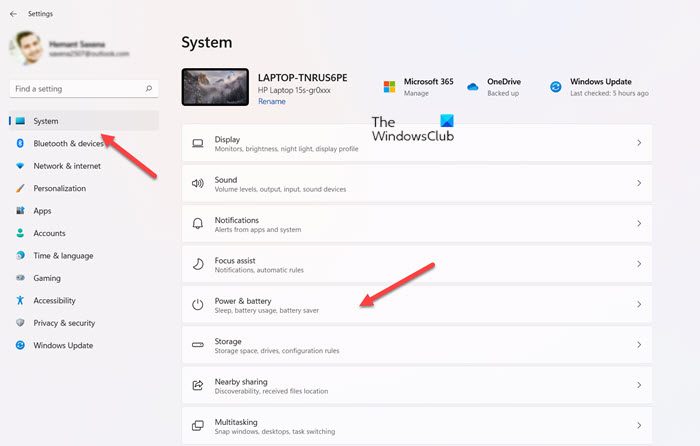
On the right, Move to Power & battery settings. Expand its settings and scroll down to Battery section.
There, hit the drop-down button next to Battery saver entry.
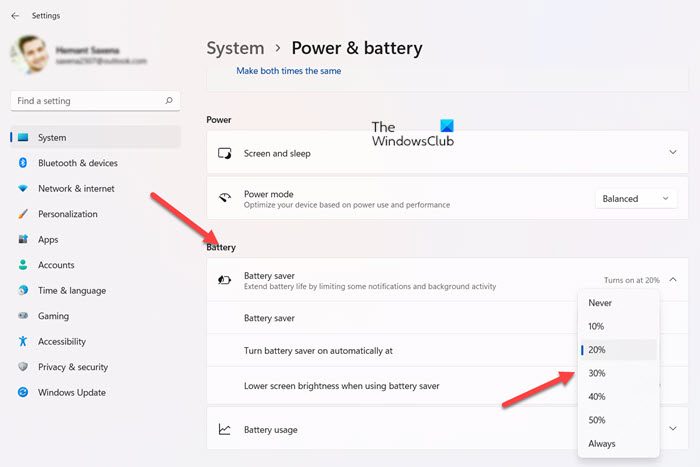
Click the drop-down menu adjacent to Turn battery saver on automatically at entry and from the list of options displayed, select the desired option.
Check Battery usage by apps Windows 11.
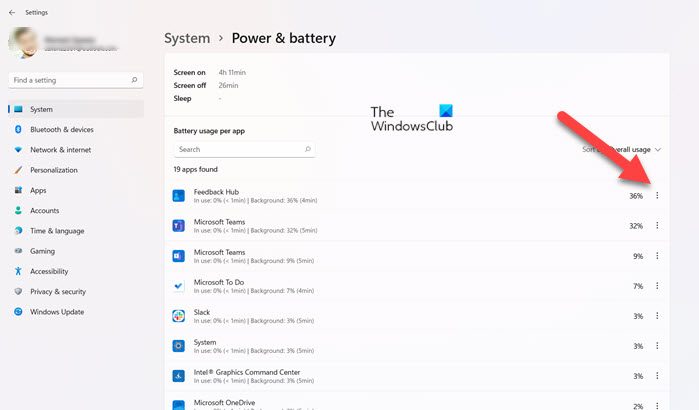
Under Battery section, just below Battery saver settings, hit the Battery usage drop-down button. Then, under Battery usage per app, check the apps consuming more power.
Click the Menu (visible as 3 vertical dots), choose Manage background activity and turn off App permissions for Camera, Location, etc.
Read: How to put apps to Sleep in Windows
Windows 10
Go to Settings and click on System.
Click on the Battery option on the left side of the System window.
Locate the Battery Saver settings and toggle the setting – Turn on battery saver on automatically if my battery falls below. Move the slider to a suitable position.
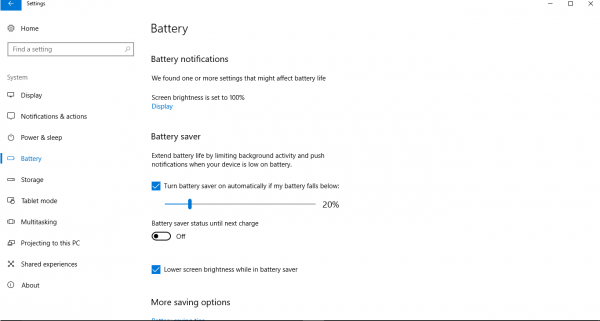
Related: Laptop Battery drains after shutdown
2] Check Battery usage by apps
To find out the battery usage of each app follow these steps.
In the battery settings, Click on the option ‘Battery Usage by app‘.
The ‘Battery usage by app’ window is displayed with all the apps and the percentage of battery consumption.
Identify the ones you think are using very high power, and see if you would like to restrict usage, disable, or remove the app/s.
Read: Windows Laptop Battery drains in Sleep Mode.
3] Use Sleep Study Tool to find out what drains your battery
Windows Sleep Study Tool is a new tool from Microsoft that helps you study what exactly is draining your battery power in a Windows InstantGo-supported computer.
Fix: Microsoft Edge battery drain issues
4] Troubleshoot Power problems with PowerCfg
PowerCfg is a command utility tool that will scan your computer for 60 seconds to know the power efficiency of your system and tracks all the issues that are draining the battery life. The tool provides detailed results in the form of an HTML report so that you can actually evaluate the cause of battery drain. In this way, you can take the necessary steps to extend battery life. Follow these steps to generate a power report and evaluate the efficiency of your system.
Run Command Prompt as administrator and execute the following command:
powercfg/energy
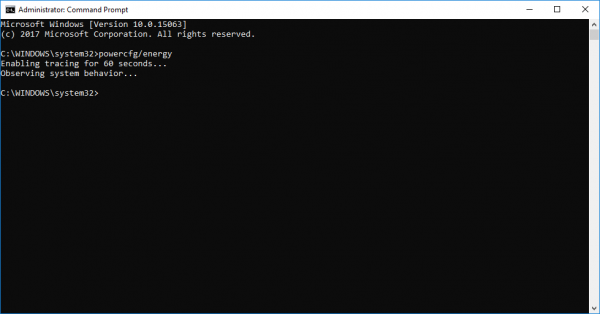
This will generate a detailed HTML report which you can check for errors.
To generate a complete battery health report type the following command in the command prompt:
powercfg/batteryreport
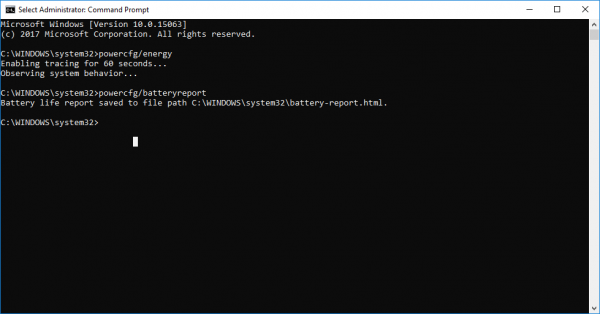
Hit Enter.
This will give a detailed HTML report on battery issues, charge ratings, history of battery use and history of battery charge periods.
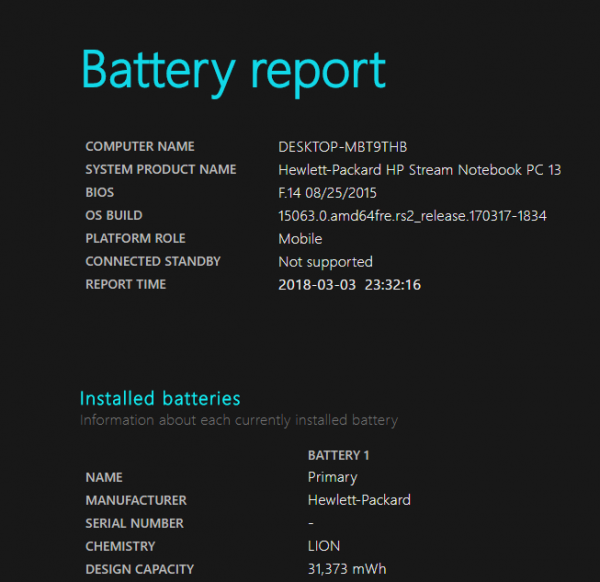
You can also run this command to determine the devices that are set so that the user can wake the computer and turn them off by using the following command:
powercfg –devicequery wake_armed
For more information about the PowerCFG options, run POWERCFG /? command in an elevated prompt.
5] Run Power Troubleshooter
Run the Power Troubleshooter and let it check for and automatically detect and fix Power issues.
Read: How to limit Battery Charge in Windows
6] Extend Battery life with customized Power Plans
Power plans help conserve energy while you maximize the system performance. It basically gives you the power to prioritize between battery life and performance. They let you customize the battery usage by planning and adjusting the screen brightness either when the system is in sleep mode or charging mode or when the system is plugged in. You can change the settings of display, brightness and sleep either when the system is on battery or when the system is plugged in. Moreover, you can change advanced power settings or restore to the default settings. The following steps will guide you in using power plans.
Go to Control Panel and click on Power options.
In the Power Options, choose to Create a Power plan. Now you will be able to Create a Power plan as per your needs.
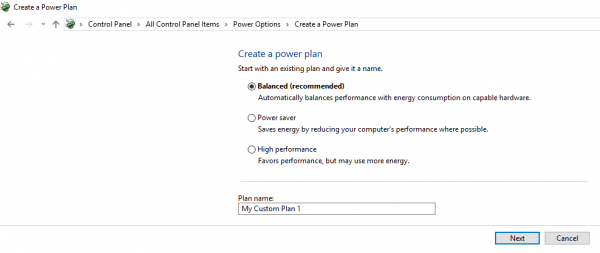
If the above solution doesn’t work for you, check if your drivers are updated. Most of the time, outdated drivers consume a lot of battery, so it is important to update the drivers to maximize device battery life as well as prevent other system-related problems from happening.
Does Battery Saver work on PC?
Yes! When you enable battery saver feature, it blocks apps running in the background. Users can still allow specific individual apps to run while in battery saver mode. In Windows, you can choose to enable battery saver when the battery level reaches a certain percentage.
Laptop battery suddenly drops to 0%
A laptop battery dropping suddenly to zero usually indicates a deteriorating battery that’s lost capacity. This often occurs with older batteries that are incapable of holding a charge. It could also be due to a calibration issue where the software misreads battery levels. You should consider replacing the battery.
How good is Windows Battery Saver?
It works really well. The setting automatically dims your display’s brightness. It’s one most useful but rarely used trick that can save battery life on every single device. In addition, the mode throttles background apps not in use currently, even if they’re desktop apps.
Read next: